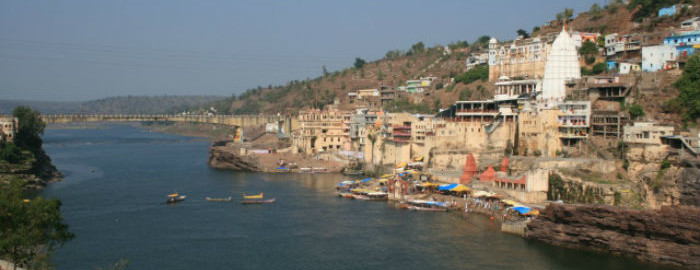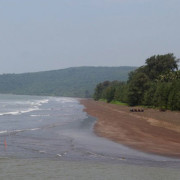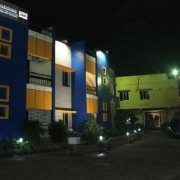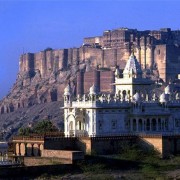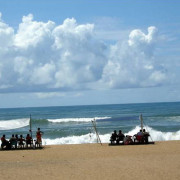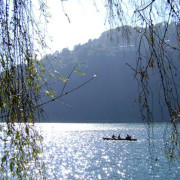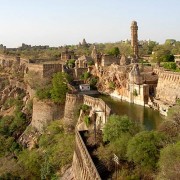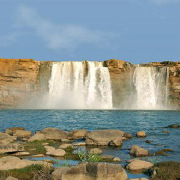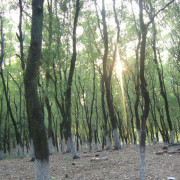Ujjain, Madhya Pradesh – An ancient city & renowned pilgrimage on the bank of the river Shipra
Ujjain is a sacred and pious land and a renowned pilgrimage of the Hindus. The existence of this city can be traced from the time of Puranas. It was named as Avantinagar at that time. The bank of the River Sipra is the hub of devotees for prayers as well as for taking a sacred bath in the river, flowing within the city. One of the 12 jyotirlingas in India, the lingam at the Mahakal is believed to be swayambhu (born of itself) deriving currents of power (shakti) from within itself as against the other images and lingams which are ritually established and invested with mantra-shakti.
It is in Ujjain that the famous poet Kalidasa wrote his eternal writings. During the time of the Aryan settlers, Ujjain seems to have acquired importance. By the 6th century B.C. Avanti with its capital at Ujjaini, is mentioned in Buddhist literature as one of the four great powers along with Vatsa, Kosala and Magadha. Ujjain is also an ideal destination for the tourists having true interest in history because of its rich historical tradition. Beginning from the Aryan age, the eminent powers like the Rashtrakutas, the Mughals, passing the Marathas upto the Scindhia’s Ujjain deserves special mention. Ujjain acquires a cultural splendour of its own which is equaled by very few other cities in India.
Today, Ujjain abounds in temples, hoary old tradition attached to each of them. But though most of them have been built upon sites of antiquity, none of them has survived in the original splendour. Desecrated and despoiled time and time again, the structures that stand today are of more recent date, renovated or rebuilt over the years. And yet, the temples form an integral part of the city and contribute to the continuity of Ujjain’s tradition of greatness.
Places to see in Ujjain: There are numerous places of visit at Ujjain:
Bade Ganeshji Ka Mandir
This temple situated above the tank near the Mahakaleshwar temple, enshrines a huge artistic sculpture of Ganesh, the son of Shiva. An idol of this size and beauty is rarely to be found. The middle of the temple is adorned by an idol of the pancha-mukhi (five faced) Hanuman. There is provision for learning of Sanskrit and Astrology in the temple.
Chintaman Ganesh
The temple is standing across the Shipra on the Fatehabad railway line. The Ganesh idol enshrined here is supposed to be swayambhu – born of itself. The temple itself is believed to be of considerable antiquity. Riddhi and Siddhi, the consorts of Ganesha, are seated on either side of Ganesha. The artistically carved pillars in the assembly hall date back to the Paramara period. Worshipers throng to this temple because the deity here is traditionally known as Chintaharan Ganesh meaning “the assurer of freedom from worldly anxieties”.
Pir Matsyendranath
This is an extremely attractive spot on the banks of the Shipra quite close to the Bhartihari Caves and the Gadkalika Temple. It is dedicated to the memory of one of the great leaders of the Natha sect of Saivism-Matsyendranath. Since muslims as well as the followers of the Natha sect call their saints ‘pir’, the ancient site of Pir Matsyendranath is venerated by both. Excavations at this site have yielded some antiquities which date back to the 6th and 7th century BC.
Bhartrihari Caves
These caves are just above the bank of the Shipra near the temple of Gadkalika. According to popular tradition, this is the spot where Bhartrihari, who is said to have been the step brother of Vikramaditya, lived and meditated after renouncing worldly life. He is believed to have been a great scholar and poet. His famous works, Shringarshatak, Vairagyashatak, and Nitishatak, are known for the exquisite use of the Sanskrit meter.
Kaliadeh Palace
Situated on the banks of the Shipra, the island-like site immediately conjures up the natural beauty of ancient Ujjain which poets down the ages have waxed lyrical. The glorious landscape of the flowing river on both sides of the palace and the man-made tanks and channels, with water gurgling through them, provide a spectacular backdrop to the imposing building. The central dome of the palace is a beautiful example of Persian architecture. Two Persian inscriptions found in one of the long corridors of the palace record the visits of Emperor Akbar and Jehangir to this palace. The palace was broken down in the time of the Pindaris and was restored by Madhav Rao Scindia in 1920 to its present glory. The Sun Temple was also restored by the family.
Durgadas Ki Chhatri
It is a distinctive monument glowing like a small jewel in the surrounding lush landscape. Vir Durgadas earned a secure niche for himself in the history of Marwad by his undaunting, selfless service to the State. He fought for the independence of Jodhpur after the death of Maharaj Jaswant Singh and helped Ajit Singh to ascend the throne against the wishes of Aurangzeb. Durgadas died at Rampura in 1718, and his funeral rites were performed according to his wishes on the banks of the Shipra. The rulers of Jodhpur had built the chhatri to consecrate his memory. This beautiful structure, built in the Rajpur style of architecture, houses a statue of Durgadas which crumbled down.
Harsiddhi Temple
This temple occupies a special place in the nebula of ancient sacred spots of Ujjain. Seated between the idols of Mahalaxmi and Mahasaraswati, the idol of Annapurna is painted in dark vermilion color. The Sri Yantra, the symbol of power or shakti, is also enshrined in the temple. According to the Shiva Purana, when Shiva carried away the burning body of Sati from the sacrificial fire, her elbow dropped at this place. There is an interesting legend in the Skanda Purana about the manner in which the Goddess Chandi acquired the epithet of Harsiddhi. Once when Shiva and Parvati were alone on Mount Kailash, two demons called Chand and Prachand tried to force their way in. Shiva called upon Chandi to destroy them which she did. Pleased, Shiva bestowed upon her the epithet of ‘one who vanquishes all’. The temple was reconstructed during the Maratha period and the two pillars adorned with lamps are special features of Maratha art. These lamps, lit during Navaratri, present a glorious spectacle. There is an ancient well on the premises, and an artistic pillar adorns the top of it.
Siddhavat
This enormous banyan tree on the banks of the Shipra, has been vested with religious sanctity as the Akashyavat in Prayag and Gaya, Vanshivat of Vrindavan and the Panchavata of Nasik. Thousands of pilgrims take a dip in the Shipra from the bathing ghat built here. According to one tradition, Parvati is believed to have performed her penance here. It used to be a place of worship for the followers of Natha sect. One legend has it that some Mughal rulers had cut off the Banyan tree and covered the site with iron sheets to prevent its roots from growing. But the tree pierced the iron sheets and grew and flourished. The little village of Bhairogarh near Siddhavat is famous for its tie and dye painting for centuries. In ancient times when trade with other countries flourished, exquisitely printed cloth from Bhairogarh used to find its way to Rome and China.
Kal Bhairava
The worship of the eight Bhairavas is a part of Saivite tradition and the chief among them is Kal Bhairava, believed to have been built by King Bhadresen, on the banks of the Shipra. There is mention of a Kal Bhairva temple in the Avanti Khanda of the Skanda Purana. Worship of Kal Bhairava is believed to have been a part of the Kapalika and Aghora sects. Ujjain was a prominent centre of these two sects. Even today, liquor is offered as a part of the ritual to Kal Bhairava Beautiful paintings in the Malwa style once decorated the temple walls, only traces of which are visible.
Sandipani Ashram
The fact that ancient Ujjain apart from its political and religious importance, enjoyed the reputation of being a great seat of learning as early as the Mahabharata period is borne out by the fact that, Lord Krishna and Sudama received regular instruction in the ashram of Guru Sandipani. The area near the ashram is known as Ankapata, popularly believed to have been the place used by Lord Krishna for washing his writing tablet. The numerals 1 to 100 found on a stone are believed to have been engraved by Guru Sandipani. The Gomti Kunda referred to in the Puranas was the source of water supply to the ashram in the olden days. An image of Nandi, belonging to the Shunga period, is to be found near the tank. The followers of Vallabha sect regard this place as the 73rd seat of the 84 seats of Vallabhacharya where he delivered his discourses throughout India.
Gadkalika
Situated about 2 miles from the city of Ujjain, the deity in this temple is believed to have been worshipped by Kalidasa. The legend goes that he was an idiot and it is by his devotion to the goddess Kalika that he acquired great literary skills. Emperor Harshavardhan had this temple renovated in the 7th century AD. There is further evidence of renovation during the Paramara period. The temple has been rebuilt in the modern times by the erstwhile Gwalior State.
Mangal Nath
This temple is situated away from the bustle of the city at a serene location and can be reached through a winding road. The temple looks upon a vast expanse of the Shipra waters and fills the onlooker with an indescribable sense of peace. Mangalnath is regarded as the birth place of Mars, according to the Matsya Purana. In ancient times, it was famous for a clear view of the planet and hence suitable for astronomical studies. Mahadev or Shiva is the deity which is worshiped in the temple of Mangalnath.
Gopal Mandir
This huge temple is situated in the middle of the big market square. It was constructed by Bayajibai Shinde, the queen of Maharajah Daulat Rao Shinde in the 19th century. It is a beautiful example of Maratha architecture. The sanctum sanctorium is inlaid with marble and doors are silver plated. The door in the inner sanctum is said to have been carried to Ghazni from the Somnath temple and from thence by Mahmud Shah Abdali to Lahore. Mahadji Scindia recovered it and now it has been installed in this temple.
Navagraha Mandir (Triveni)
Situated on the Triveni Ghat of the Shipra, the temple is located away from the old site of Ujjaini town. It is dedicated to the nine planets, attracts large crowds on new moon days falling on Saturdays. Its religious importance has increased in recent years though there is no known reference to it in the ancient texts.
Mahakaleshwar
The god of the gods Lord Shiva, in all his splendor reigns eternal in Ujjain. The temple of Mahakaleshwar, its Shikhara soaring into the skies, evokes primordial awe and reverence with its majesty. The Mahakal dominates the life of the city and its people, even in the midst of the busy routine of modern preoccupations, and provides an unbreakable link with past traditions.
The Vedha Shala (Observatory)
Ujjain enjoyed a position of considerable importance in the field of astronomy. Great works on astronomy such as the Surya Siddhanta and the Panch Siddhanta were written in Ujjain. According to Indian astronomers, the Tropic of Cancer is supposed to pass through Ujjain. It is also the fist meridian of longitude of the Hindu geographers. From about the 4th century BC, Ujjain enjoyed the reputation of being India’s Greenwich. The observatory extant today was built by Raja Jai Singh (1686-1743), who was a great scholar. He translated the works of Ptolemy and Euclid into Sanskrit from Arabic. Of the many observatories built by him at Jaipur, Delhi, Varanasi, Mathura, and Ujjain, the one at Ujjain is still in use actively. Astronomical studies are conducted through the Department of Education and the ephemeris is published every year. There is a small planetarium and a telescope to observe the moon, Mars, Jupiter and their satellites. The observatory is also used for weather forecasts.
Vikram Kirti Mandir
Established on the occasion of the second millennium of the Vikram era, this was the cultural centre to perpetuate the memory of Vikramaditya, the Vikram Kirti Mandir houses the Scindia Oriental Research Institute, an archaeological museum, an art gallery and an auditorium. The Scindia Oriental Research Institute has an invaluable collection of 18,000 manuscripts on various subjects and runs a reference library of important oriental publications. Rare manuscripts in Prakrit, Arabic, Persian and other Indian languages cover a wide range of subjects from Vedic literature and philosophy to dance and music. Palm leaf and bark leaf (Bhurja Patra) manuscripts are also preserved in this institute. Apart from an illustrated manuscript of Shrimad Bhagavata in which actual gold and silver have been employed for the paintings, the Institute has a rich collection of old paintings in the Rajput and Mughal style. The museum also exhibits a rich array of images, inscriptions, copper plates and fossils discovered in the Narmada valley. A huge skull of a primitive elephant is of special interest. Vikram University: A famous centre of learning in the past, Ujjain continues to uphold that tradition. The establishment of the Vikram University in 1957 was an important landmark. Situated on the Dewas Road, this university plays a significant role in the literary and cultural activities of the city.
Kalidasa Academy
The academy was set up in Ujjain by the Government of Madhya Pradesh to immortalize the memory of the great poet dramatist-Kalidasa, and to create a multi-disciplinary institution to project the genius of the entire classical tradition, with Kalidasa as the apex, enable research and study in Sanskrit classical and traditional performing arts, and facilitate its adaptation for contemporary stage in different cultural settings and language groups. The Academy complex consists of a theatre, museum, library, lecture and seminary halls, mini stage for rehearsals, research facilities for scholars, and a large open air theater.
Ram Janardhan Temple, Ram Ghat, Harihara Teertha, Mallikarjuna Teertha, Ganga Ghat, Bohron Ka Roja, Begum Ka Maqbara, Bina Neev Ki Masjid, Maulana Rumi Ka Maqbara, and Digambara Jain Museum are some of the other prominent places of interest in Ujjain.
Nearby Attractions from Ujjain: From Ujjain you can arrange a trip to the places like:
Dewas
36 km from Indore on the National Highway No. 3, Dewas is famous for its hill- top temple of Devi Chamunda.
Agar
66 km from Ujjain it is an ancient archaeological site.
Nagda
60 km from Ujjain. It is an industrial town with ancient temples.
Sailana
Sailana, 21 km from Ratlam is famous for its cactus garden with over 1200 species of cactus (only 50 are Indian); perhaps the biggest collection in Asia. It is also famous for its culinary tradition.
Maksi
39 km from Ujjain, it is famous for Jain temples.
Mandsaur
84 km from Ratlam, Mandsaur is famous for the Ashtamukhi Pashupatinath Temple situated on the river Sivana. The width of the temple varies from 2 to 33 metres and its height from 3 to 55 metres.
Gandhi Sagar
The river Chambal has been dammed at Gandhi Sagar, situated 91 km from Neemuch, at the border of Madhya Pradesh and Rajasthan. The water spread is extremely scenic and picturesque.
Bhanpura
Situated in the Mandsaur district, this place gets its name from King Bhaman. It is 127 km from Mandsaur, and has a museum depicting the popular arts of Mandsaur. Illustrated oil paintings are also to be found around Bhanpura. At the museum, art from the Gupta era to the time of the Pratihars and Parmars is depicted, and well- sculpted portraits of Uma- Maheshwar, Kartikaey, Vishnu, Gavoi and Nandi are displayed.
Indore
It is the Commercial Capital of Madhya Pradesh.
Things to do at Ujjain: Apart from this the sight scene trips, visit to Ujjain will remain incomplete if you come back without buying any souvenir or memento from the place. Ujjain is also known for stone crafts, that is, beautiful small statues carved out of stone. If one ponders on what to buy in Ujjain, one should head straight to the local bazaars and the handicrafts emporium to get exclusive and ethnic artifacts of Madhya Pradesh. Simhastha is the great bathing festival of Ujjain, which is celebrated once in twelve years. Ceremonial bathing in the holy waters of Shipra begin with the full moon day of Chaitra (March) and continue up to the next full moon day.
Best time to visit Ujjain: The best period to visit Ujjain is from October to March when the climatic condition remains soothing.
How to go ?
By Air
The nearest airport is at Indore (55 km) which is connected by flights with Delhi, Bhopal and Mumbai.
By Road
Regular bus services connect Ujjain with Indore, Bhopal, Ratlam, Gwalior, Mandu, Dhar and Omkareshwar.
By Rail
Ujjain is connected with Mumbai, Delhi, Bangalore, Ahmedabad, Allahabad, Kolkata, Chennai & Cochin.
Where to stay ?
There are plenty of lodges and hotels as well as guest houses both government and non government in Ujjain. Some options are:
Shipra Residency: +91-0734- 255 1495
Avantika Yatriniwas: +91-0734-2511398
Hotel Raj Palace: +91-0734-2530325, 4011006 Website: www.hotelrajpalaceujjain.com
Hotel Grand Tower: +91-0734- 255 3699 Website: hotelgrandtower.com
Note : Phone numbers given above are according to the information available with us. If you find any contact number/s given above is/are incorrect or not in use, please let us know.
.
.

